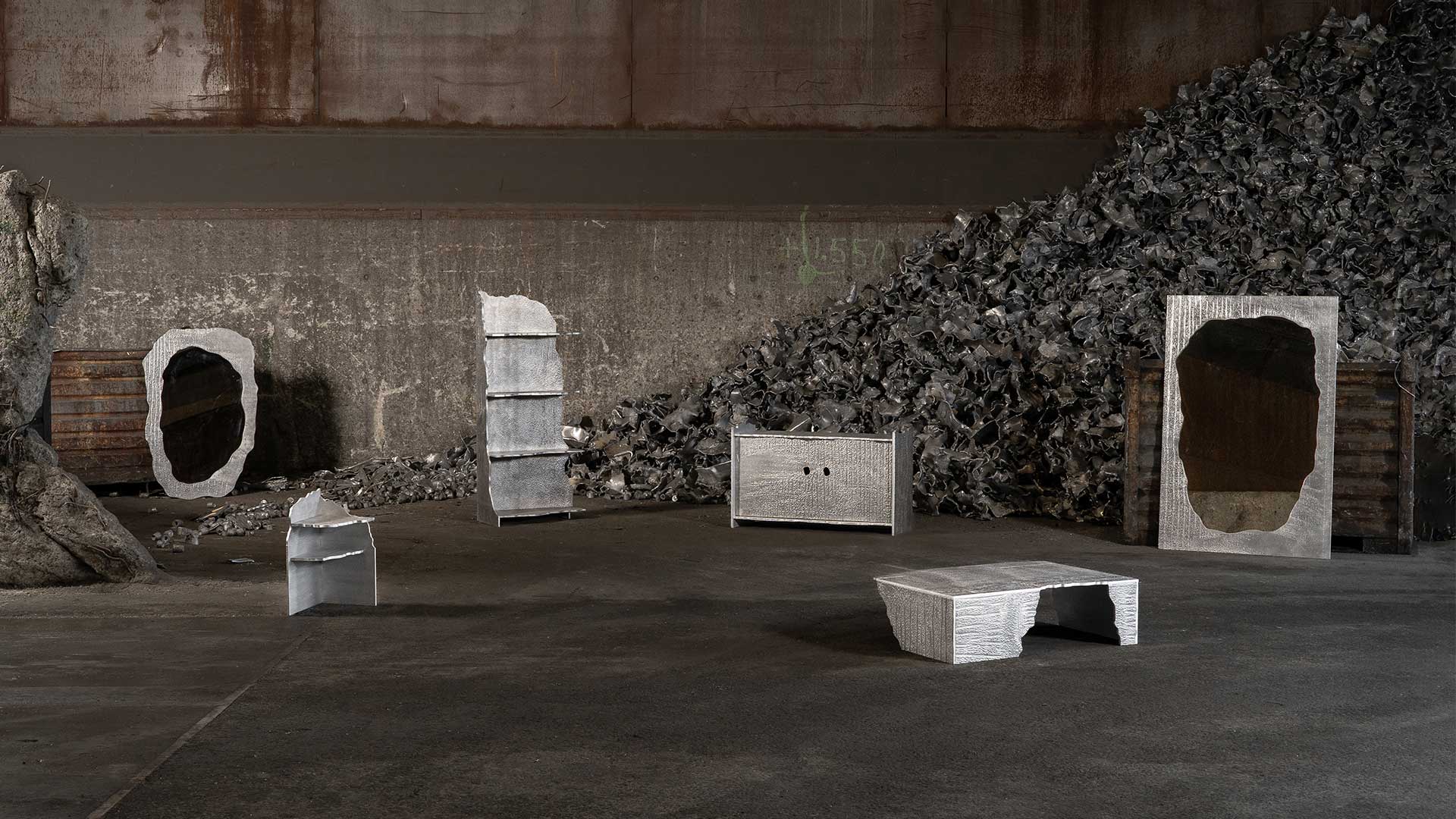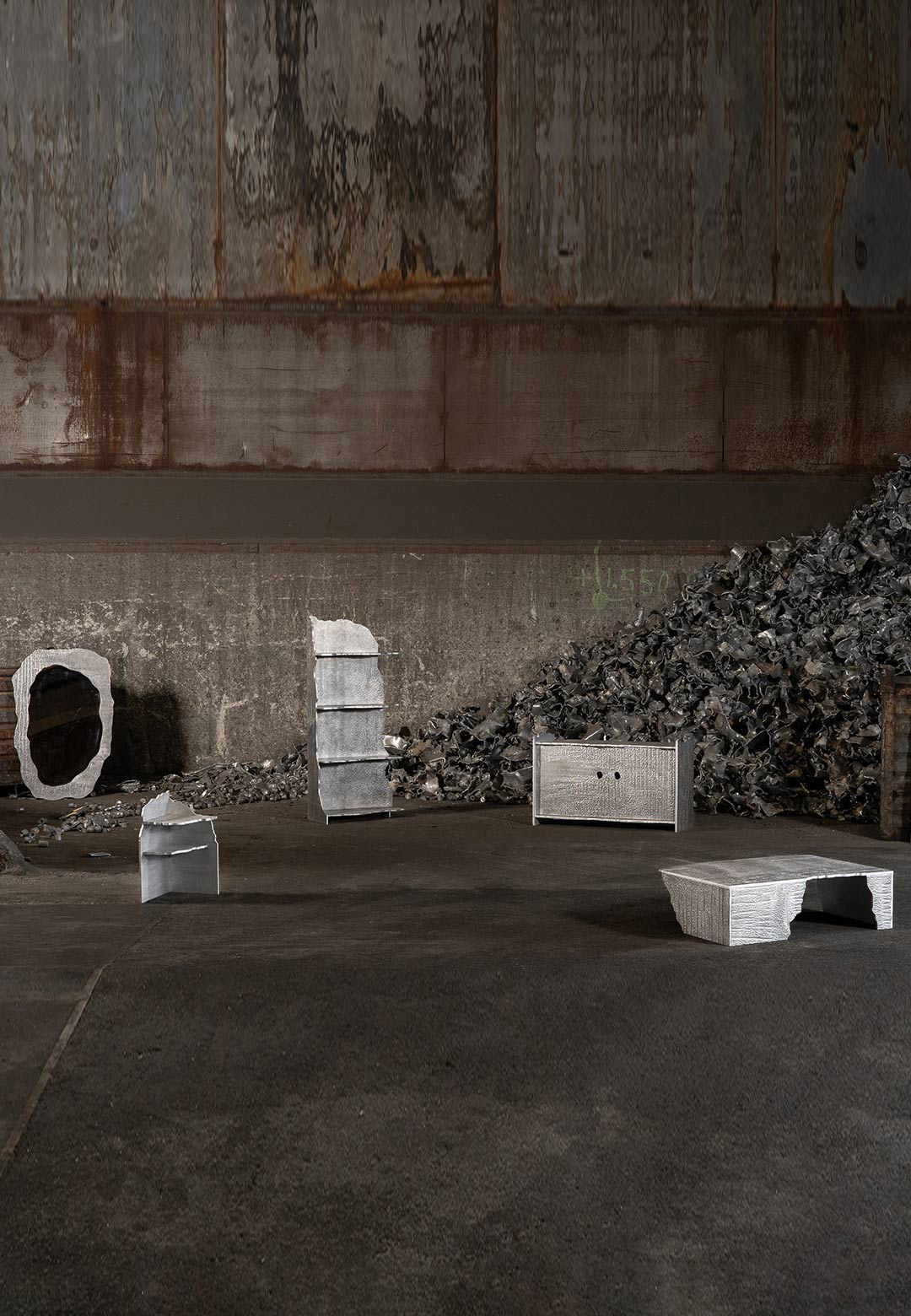What does one do with leftover bits of vegetables after the curry is cooked and ready? Half a piece of onion, a quarter portion of tomato or skinned garlic—none of these leftover ingredients are discarded after the preparation of a meal. Instead, they are utilised as garnishes and salads to further enhance meals. Much like the organic and deeply personal process of preparing meals, sculpting objects by hand embodies this gesture of conscientious consideration for materials. For instance, the offcuts from handmade wooden furniture, vestigial metal left over from hand-sculpted utensils or yarn remnants from a sweater, are seldom cast off as waste. They become patches and streaks that are used to remedy damages and at other times, serve as adornments.
In the case of industrially produced objects, however, such generous care and consideration towards material offcuts often ceases. One can ascribe this disregard to the fragmentation of work and isolation of workers in an industrial setup. With the designated jobs of designing, cutting, smoothening, polishing and packaging, each worker remains dissociated from the overall process and the final product. This, in turn, leads to a certain disregard for any waste that might be incurred as part of the production process. Instead, the focus remains on consistently producing perfectly shaped iterations of the finalised design.
As various designers come to terms with the wastefulness of such a system, they have begun to visualise processes wherein material offcuts are minimally produced, and usage can be found for the scant waste generated as part of the larger process. Studio ThusThat, a design practice based in Amsterdam, the Netherlands, recently designed a collection of furniture and homeware objects that utilises recycled aluminium off-cut ‘crusts.’ This collection, namely One Side Sawn, is on display at Paris-based ToolsGalerie, from January 26 to March 16, 2024.
Led by Kevin Rouff and Paco Boeckelmann, Studio ThusThat focuses on experimenting to create alternative making and building processes. “ThusThat's broad goal is to uncover narratives behind everyday materials, in such a way that has us (be it the public, companies, brands, etc.) reflect on the inherent implications of those materials' use,” Rouff shares. The product designers clarify that they are not specifically intent on delivering the message of sustainability, through their work. Instead, Rouff and Boeckelmann study materials and their origin to sculpt them through alternative processes that may help present them in a disparate manner. “While a lot of our previous work dealt with industrial and toxic mining wastes, although there are obvious messages there about sustainability and circularity, our goal was to have us reconsider the aesthetic culture behind some of these demonised materials, particularly if science has paved ways for their use,” the designers shared.
During the early stages of aluminium production, the parts extruding beyond the boundaries designated for aluminium blocks are sawn off. These parts are called ‘crusts.’ They are thin raw-textured plates. Each piece in the One Side Sawn collection uses single sheets of aluminium salvaged from the aforementioned ‘crusts.’ The One Side Sawn pieces are cut and shaped to use every bit, of each sheet, is utilised, leaving no off-cuts behind. This was a self-assigned challenge that the designers took up, intending to develop an appreciation and embrace imperfections that are inherent to secondary materials. This principle of reusing offcuts in a manner such that the cuts made for one object informed the form of the next object, led to an overall organic process, wherein the design and form of the pieces were not predetermined. “The result is a large ad-hoc puzzle of jagged cuts and an unusual composition of pieces that echo the brute and raw production of aluminium,” the designers shared.
The title of the collection and the exhibition allude to two factors. First, the industrial process that leaves behind offcuts, and, second, the intention of this collection, is to reveal the inherent character of aluminium and the processes that guide its making. Some of the different pieces that make up the collection include a coffee table and side table, a standing shelf and wall shelf, a magazine holder, a tray, an ashtray, vases, mirrors, a sideboard and a floor lamp.
Since the material utilised to build the objects is already recycled, the designers’ main concern was not that of addressing circularity. “The material came to represent, for us, a rough and raw counter side to a metal we take for granted. In a way, the pristine customary look of aluminium is telling of many of our expectations for perfect, virgin materials. The crust, by contrast, shows the rougher underbelly, a trace of the brute nature of its extraction, production, and indeed, even its recycling. We think that this aesthetic, one that embraces its rawness, is important to [acclimate] ourselves to a world in which secondary materials, tampered landscapes, and the imperfect will inevitably become more prevalent in the face of scarcity and rising demands,” Rouff explains.
The jagged and rough edges of the aluminium sheets give form to a unique concurring aesthetic, evident in all the pieces. While the rear of the plates still shows traces of the giant factory saws used to cut them, the front-facing surface of the furniture reveals aluminium’s inherent patterns. These details, clubbed with the overall raw aesthetic of the pieces, draws attention to the processes that shape metallic entities.
As part of the exhibition in Paris, France, Studio ThusThat also made the crust sheets available in various different sizes and formats, in order to encourage its usage in architectural and interior design projects. All these sheets are infinitely recyclable.
The exhibition ‘One Side Sawn’ is on view from January 26 to March 16, 2024, at ToolsGalerie, in Le Marais, Paris, France.






 Sign in with email
Sign in with email










What do you think?